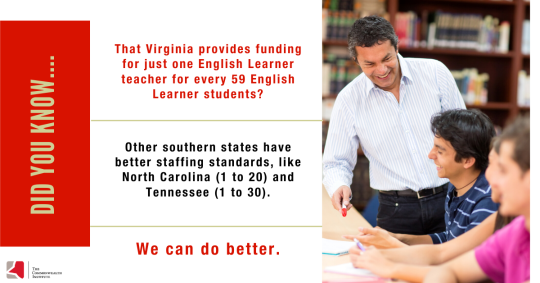February 12, 2020
High-Quality Education in Virginia Can’t Exist Without Adequate English Learner Teachers
Central to creating a high-quality education under which students can thrive is having a team of support and instructional staff that can meet a diverse set of needs at every school. English Learner (EL) teachers are a critical part of that need, but the current required ratio of one teacher to every 59 students isn’t enough. The state legislature is currently reviewing proposals from the Virginia Board of Education and the governor to make critical improvements to how we support our EL students. The number of EL students has almost doubled since the last time the legislature improved funding. Action is long overdue, and Virginia’s English Learners should not have to wait any longer.
The Virginia Board of Education’s newly prescribed Standards of Quality include increases in EL instructor staffing. Further than simply increasing EL staff, it ties staffing ratios to student language ability, so students who need the most support get the most support. It would increase instructional positions for students with the lowest English proficiency (1 teacher to 25 students), and provide continued support at different staffing levels for students who are more proficient and on their way to fluency.
Several bills have been put forward that would increase the number of EL teachers, but not all of them meet what the Board identifies as the bare minimum. The governor’s proposed budget, which would increase instructional positions for EL students to 20 positions for every 1,000 students (equivalent to 1 teacher for every 50 students) by allocating $27.6 million over both years of the budget, is less than half of what the Board recommends to adequately support the state’s EL students ($62.8 million over the-two year budget).
Sen. Hashmi (SB 910) and Del. Guzman (HB 975) have proposed legislation to implement the Governor’s proposal. The House version was amended down in the Appropriations Committee to instead require 18.5 EL instructors for every 1,000 EL students (or 1 teacher for every 54 students) in the first year of the budget – an estimated $6.7 million cut from the governor’s proposal. The Senate version was amended to add a clause saying the legislation will only take effect if it is included in the budget. Both bills were passed by their respective chambers.
Del. Aird’s (HB 1316) and Sen. McClellan’s (SB 728) legislation would fully fund the Board’s proposal of one EL teacher for every 25 EL students at the lowest level of English proficiency and continued instructional support for students with higher proficiency. Del. Aird’s bill did not receive a hearing in the House Appropriations Committee and Sen. McClellan’s was passed by the Senate with a clause that makes enactment contingent on funding being included in the budget.
Other southern states have significantly better staffing standards for their EL students than Virginia’s current standard of one teacher for every 59 students. This includes North Carolina (1 to 20) and Tennessee (1 to 30). Virginia also lags behind in terms of funding, spending about 12% more per EL student, compared to the national average of 39% more per student beyond the state support base. Neighboring states like Maryland go as high as 99% more.

The consequences of insufficient staffing for EL students are clear. In 2019, pass rates for EL students were 47.5 percentage points lower than non-EL students on the reading SOL test – the largest gap of any major student subgroup in state SOL data. The gap was even larger between Latinx EL and all non-EL students (52 percentage points), demonstrating that staffing as it stands perpetuates racial inequities in schools.
And Virginia doesn’t graduate as many EL students as it does non-EL students. Just last year, only 7 out of 10 EL students graduated within four years of entering high school – compared to 9 out of 10 for all students. Since 2015, students who have had or currently have EL status in school have seen a 9 percentage point drop in four-year graduation rates, from over 80% to around 71% in 2019. This isn’t acceptable, nor is it equitable.
While test scores and graduation rates are important measures of a school system, it’s also important to assess whether students of all backgrounds have equal access to programs that recognize achievement and offer challenging coursework. EL students make up only 2% of Virginia’s gifted student population, even though they make up nearly 9% of the student population. Without adequate support, EL students may stand less of a chance at being identified for these programs, which actively creates unequal opportunities within Virginia schools.
As lawmakers consider the state budget, they should remember that money matters for education. It is necessary for improving student outcomes and growing a strong economy. When legislation is changed to provide even less than what the proposed budget includes, barriers are reinforced instead of broken down, and a message is sent to students and families in Virginia about how their needs are considered. We urge lawmakers to invest in EL students and fully fund the Board’s recommendations for EL teacher staffing.
Category:
Education
